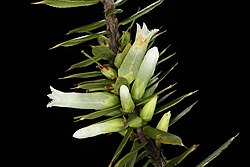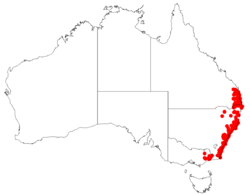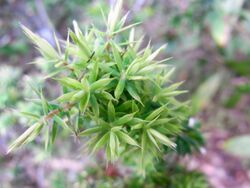Biology:Leucopogon juniperinus
| Prickly bearded heath | |
|---|---|

| |
| Leucopogon juniperinus in the Australian National Botanic Gardens | |
| Scientific classification | |
| Kingdom: | Plantae |
| Clade: | Tracheophytes |
| Clade: | Angiosperms |
| Clade: | Eudicots |
| Clade: | Asterids |
| Order: | Ericales |
| Family: | Ericaceae |
| Genus: | Leucopogon |
| Species: | L. juniperinus
|
| Binomial name | |
| Leucopogon juniperinus R.Br.[1]
| |

| |
| Occurrence data from AVH | |
| Synonyms[1] | |
| |
Leucopogon juniperinus, commonly known as prickly beard-heath,[2] is a species of flowering plant in the heath family Ericaceae and is endemic to south-eastern continental Australia. It is an erect, densely-branched shrub with oblong to more or less egg-shaped leaves with the narrower end towards the base, and white, tube-shaped flowers arranged singly in upper leaf axils.
Description
Leucopogon juniperinus is an erect, densely-branched shrub that typically grows to a height of up to about 1 m (3 ft 3 in), and has softly-hairy branchlets. The leaves are oblong to more or less egg-shaped with the narrower end towards the base, 5.6–11.8 mm (0.22–0.46 in) long and 1.2–2.5 mm (0.047–0.098 in) wide on a petiole 0.3–0.6 mm (0.012–0.024 in) long. The edges of the leaves are finely toothed, there is a sharp point up to 1 mm (0.039 in) long on the tip, and the surfaces are more or less glabrous. The flowers are arranged singly in upper leaf axils on a peduncle about 1 mm (0.039 in) long, with bracteoles 1.3–1.7 mm (0.051–0.067 in) long at the base. The sepals are 2.8–4 mm (0.11–0.16 in) long, the petals white and joined at the base to form a tube 5.4–7.9 mm (0.21–0.31 in) long with lobes 1.9–2.9 mm (0.075–0.114 in) long. Flowering occurs from May to October and the fruit is a smooth, glabrous, oval to elliptic drupe 3.2–4 mm (0.13–0.16 in) long.[2][3][4]
Taxonomy
Leucopogon juniperinus was first formally described in 1810 by Robert Brown in his Prodromus Florae Novae Hollandiae et Insulae Van Diemen.[5][6] The specific epithet (juniperinus) means "juniper-like".[3]
Distribution and habitat
Prickly beard-heath grows in forest and open shrubland on the coast and nearby tablelands of south-eastern Queensland, New South Wales and east of the Mitchell River in Victoria.[2][4][7]
References
- ↑ 1.0 1.1 "Leucopogon juniperinus". https://biodiversity.org.au/nsl/services/apc-format/display/99919.
- ↑ 2.0 2.1 2.2 Powell, Jocelyn M.. "Leucopogon juniperinus". Royal Botanic Garden Sydney. https://plantnet.rbgsyd.nsw.gov.au/cgi-bin/NSWfl.pl?page=nswfl&lvl=sp&name=Leucopogon~juniperinus.
- ↑ 3.0 3.1 Robinson, Les (1991). Field guide to the native plants of Sydney. Kenthurst, NSW: Kangaroo Press. p. 109. ISBN 0864171927.
- ↑ 4.0 4.1 Benson, Doug; McDougall, Lyn (1995). "Ecology of Sydney plant species Part 3: Dicotyledon families Cabombaceae to Eupomatiaceae". Cunninghamia 4 (2): 371–372. https://www.rbgsyd.nsw.gov.au/getmedia/050a0f06-8c1a-4708-8858-b6d2e40fe5c3/Volume-4(2)-1995-Cun4Ben217-431.pdf.aspx. Retrieved 9 January 2023.
- ↑ "Leucopogon juniperinus". APNI. https://id.biodiversity.org.au/instance/apni/526642. Retrieved 9 January 2023.
- ↑ Brown, Robert (1810). Prodromus florae Novae Hollandiae et Insulae Van-Diemen, exhibens characteres plantarum. London. p. 546. https://www.biodiversitylibrary.org/item/21871#page/414/mode/1up. Retrieved 9 January 2023.
- ↑ Powell, Jocelyn M.; Walsh, Neville G.; Brown, Elizabeth A.. "Styphelia sieberi". Royal Botanic Gardens Victoria. https://vicflora.rbg.vic.gov.au/flora/taxon/d0bad5fb-c2c0-4f49-b663-2d1b9fc04db5.
Wikidata ☰ Q6534230 entry
 |


